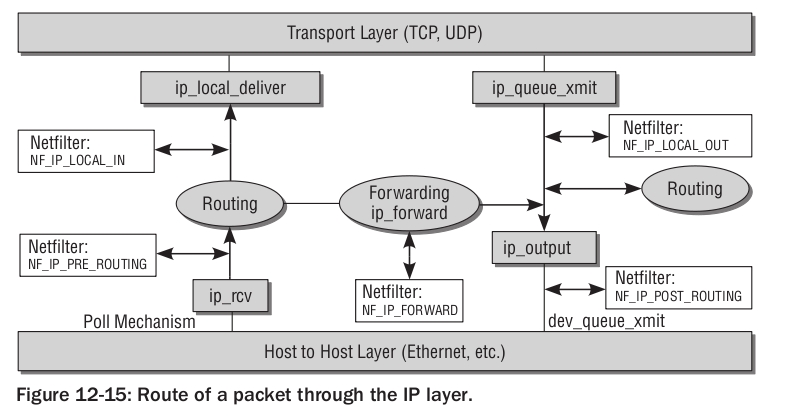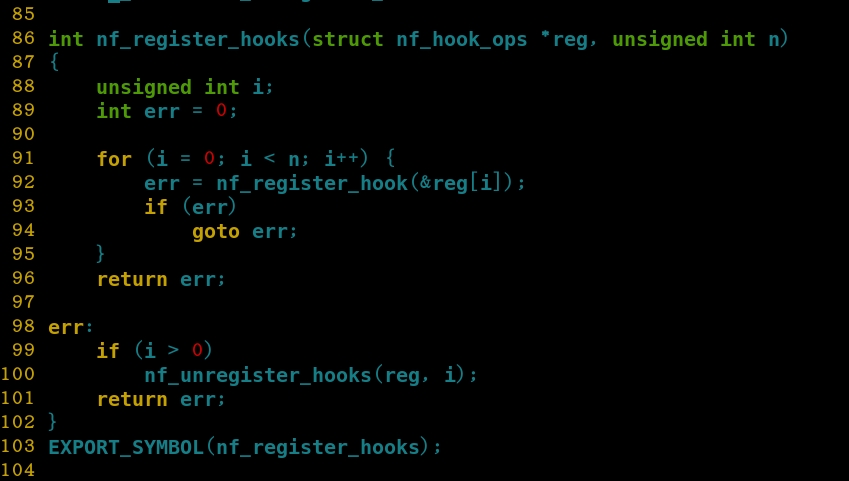linux内核中的hook函数详解
在编写linux内核中的网络模块时,用到了钩子函数也就是hook函数。现在来看看linux是如何实现hook函数的。
先介绍一个结构体:
struct nf_hook_ops,这个结构体是实现钩子函数必须要用到的结构体,其实际的定义为:
其中的成员信息为:
hook :是一个函数指针,可以将自定义的函数赋值给它,来实现当有数据包到达是调用你自定义的函数。自定义函数的返回值为:
owner:是模块的所有者,一般owner = THIS_MODULE ;
pf :是protocol flags,其取值范围为:
hooknum :中存放的是用户自定义的钩子函数的调用时机,其取值为:
其中的每个值的含义为:
priority : 为所定义的钩子函数的优先级,其取值为份两种:分别为IPV4 和 IPV6;
priority 的IPV4取值为:
priority 的IPV6取值为:
以上是对struct nf_hook_ops结构体中的每个字段的详解;
现在举例:
struct nf_hook_ops my_hook = {
.hook = myfunction,
.owner = THIS_MODULE ,
.pf = NFPROTO_IPV4,
.hooknum = NET_INET_FORWARD ,
.priority = NF_IP4_PRI_FIRST };
unsigned int myfunction( unsigend int hooknum, struct sk_buff *skb,
const struct net_device *in,
const struct net_device *out,
int (*okfn)(struct sk_buff *) )
{
}如上面的代码一样,当定义一个struct nf_hook_ops结构体,并且对其完成了初始化以后,需要将这个结构体进行注册,之后这个结构体以及其中的自定义函数才会其作用。
注册一个struct nf_hook_ops需要用到的函数为:
int nf_register_hook( struct nf_hook_ops *reg )
其实这个 int nf_register_hook()函数在内核中的实现也没有多么的复杂,
来看看它是如何实现的:
当不再需要使用这个struct nf_hook_ops时,需要注销这个结构体,其可用的函数为:
void nf_unregister_hook( struct nf_hook_ops *reg )
当一次需要注册多个struct nf_hook_ops结构体,如:
struct nf_hook_ops myhooks[n]时,使用:
int nf_register_hooks( struct nf_hook_ops *regs, unsigned int n );
同样,当一次需要注销多个struct nf_hook_ops结构体是,使用:
void nf_unregister_hoos( struct nf_hook_ops *regs, unsigned int n );
总结:
struct nf_hook_ops
int nf_register_hook( struct nf_hook_ops *reg );
void nf_unregister_hook( struct nf_hook_ops *reg );
int nf_register_hooks( struct nf_hook_ops *regs, unsigend int n );
void nf_unregister_hooks( struct nf_hook_ops *regs, unsigned int n );
本文出自 “阿辉仔” 博客,请务必保留此出处http://weiguozhihui.blog.51cto.com/3060615/1584577
郑重声明:本站内容如果来自互联网及其他传播媒体,其版权均属原媒体及文章作者所有。转载目的在于传递更多信息及用于网络分享,并不代表本站赞同其观点和对其真实性负责,也不构成任何其他建议。
















































